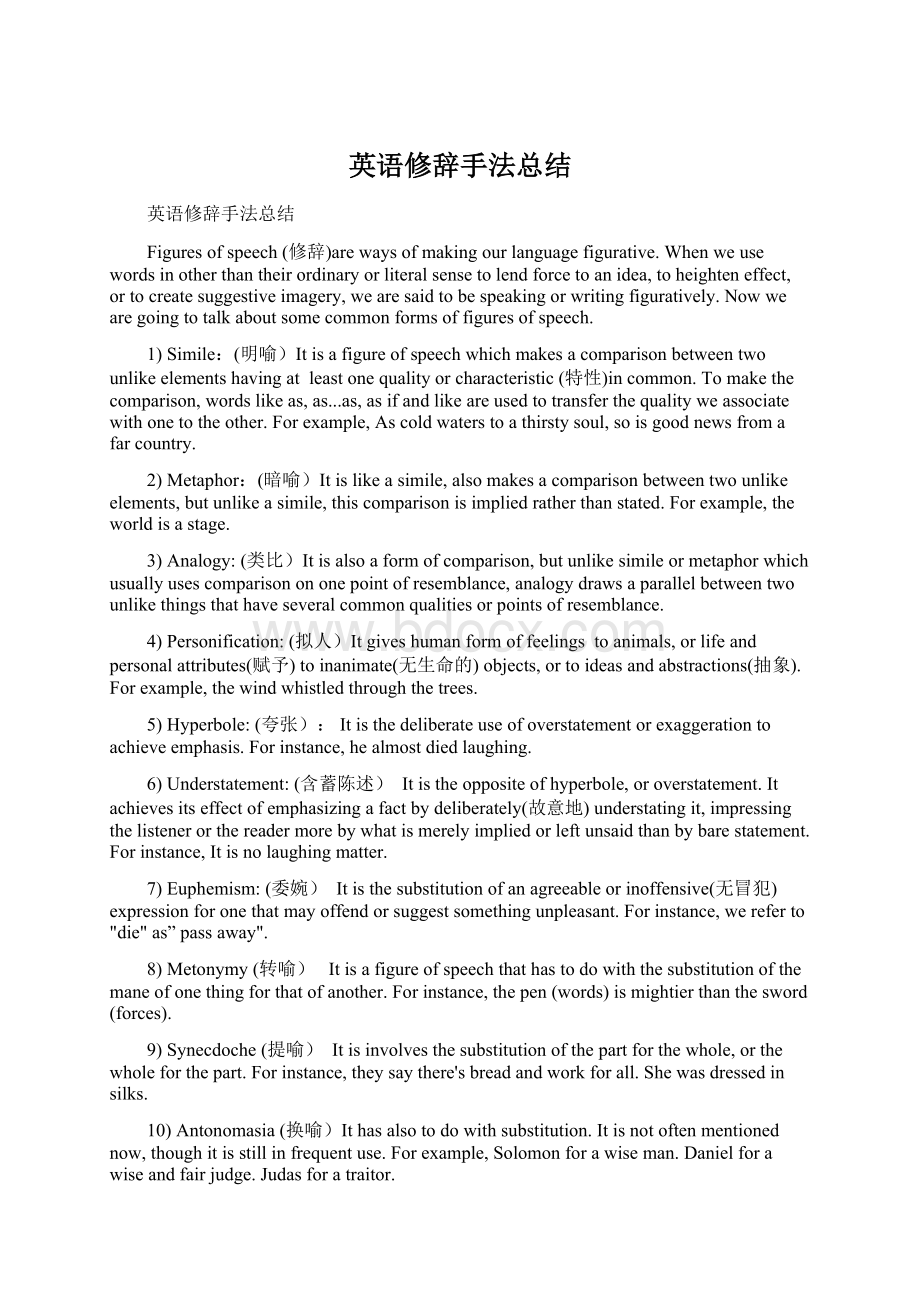英语修辞手法总结.docx
《英语修辞手法总结.docx》由会员分享,可在线阅读,更多相关《英语修辞手法总结.docx(14页珍藏版)》请在冰豆网上搜索。

英语修辞手法总结
英语修辞手法总结
Figuresofspeech(修辞)arewaysofmakingourlanguagefigurative.Whenweusewordsinotherthantheirordinaryorliteralsensetolendforcetoanidea,toheighteneffect,ortocreatesuggestiveimagery,wearesaidtobespeakingorwritingfiguratively.Nowwearegoingtotalkaboutsomecommonformsoffiguresofspeech.
1)Simile:
(明喻)Itisafigureofspeechwhichmakesacomparisonbetweentwounlikeelementshavingat leastonequalityorcharacteristic(特性)incommon.Tomakethecomparison,wordslikeas,as...as,asifandlikeareusedtotransferthequalityweassociatewithonetotheother.Forexample,Ascoldwaterstoathirstysoul,soisgoodnewsfromafarcountry.
2)Metaphor:
(暗喻)Itislikeasimile,alsomakesacomparisonbetweentwounlikeelements,butunlikeasimile,thiscomparisonisimpliedratherthanstated.Forexample,theworldisastage.
3)Analogy:
(类比)Itisalsoaformofcomparison,butunlikesimileormetaphorwhichusuallyusescomparisonononepointofresemblance,analogydrawsaparallelbetweentwounlikethingsthathaveseveralcommonqualitiesorpointsofresemblance.
4)Personification:
(拟人)Itgiveshumanformoffeelings toanimals,orlifeandpersonalattributes(赋予)toinanimate(无生命的)objects,ortoideasandabstractions(抽象).Forexample,thewindwhistledthroughthetrees.
5)Hyperbole:
(夸张):
Itisthedeliberateuseofoverstatementorexaggerationtoachieveemphasis.Forinstance,healmostdiedlaughing.
6)Understatement:
(含蓄陈述) Itistheoppositeofhyperbole,oroverstatement.Itachievesitseffectofemphasizingafactbydeliberately(故意地)understatingit,impressingthelistenerorthereadermorebywhatismerelyimpliedorleftunsaidthanbybarestatement.Forinstance,Itisnolaughingmatter.
7)Euphemism:
(委婉) Itisthesubstitutionofanagreeableorinoffensive(无冒犯)expressionforonethatmayoffendorsuggestsomethingunpleasant.Forinstance,wereferto"die"as”passaway".
8)Metonymy (转喻) Itisafigureofspeechthathastodowiththesubstitutionofthemaneofonethingforthatofanother.Forinstance,thepen(words)ismightierthanthesword(forces).
9)Synecdoche (提喻) Itisinvolvesthesubstitutionofthepartforthewhole,orthewholeforthepart.Forinstance,theysaythere'sbreadandworkforall.Shewasdressedinsilks.
10)Antonomasia (换喻)Ithasalsotodowithsubstitution.Itisnotoftenmentionednow,thoughitisstillinfrequentuse.Forexample,Solomonforawiseman.Danielforawiseandfairjudge.Judasforatraitor.
11)Pun:
(双关语) Itisaplayonwords,orratheraplayontheformandmeaningofwords.Forinstance,acannon-balltookoffhislegs,sohelaiddownhisarms.(Here"arms"hastwomeanings:
aperson'sbody;weaponscarriedbyasoldier.)
12)Solipsism:
(一语双叙) Ithastwoconnotations.Inthefirstcase,itisafigurebywhichaword,oraparticularformorinflectionofaword,referstotwoormorewordsinthesamesentence,whileproperlyapplyingtooragreeingwithonlyonofthemingrammarorsyntax(句法).Forexample,Headdressedyouandme,anddesiredustofollowhim.(Hereweareusedtorefertoyouandme.)
Inthesecondcase,itawordmayrefertotwoormorewordsinthesamesentence.Forexample,whilehewasfighting,andlosinglimbandmind,anddying,othersstayedbehindtopursueeducationandcareer.(Heretolosingone'slimbsinliteral;toloseone'smindisfigurative,andmeanstogomad.)
13)Zeugma:
(轭式搭配) Itisasinglewordwhichismadetomodifyortogoverntwoormorewordsinthesamesentence,witherproperlyapplyinginsensetoonlyoneofthem,orapplyingtothemindifferentsenses.Forexample,thesunshallnotburnyoubydayorthemoonbynight.(Herenoonisnotstrongenoughtoburn)
14)Irony:
(反语) Itisafigureofspeech thatachievesemphasisbysayingtheoppositeofwhatismeant,theintendedmeaningofthewordsbeingtheoppositeoftheirusualsense.Forinstance,wearelucky,whatyousaidmakesmefeelrealgood. 15)Innuendo:
(暗讽) Itisamildformofirony,hintinginaratherroundabout(曲折)wayatsomethingdisparaging(不一致)oruncomplimentary(不赞美)tothepersonorsubjectmentioned.Forexample,theweathermansaiditwouldbeworm.Hemusttakehisreadingsinabathroom.
16)Sarcasm:
(讽刺) ItSarcasmisastrongformofirony.Itattacksinatauntingandbittermanner,anditsaimistodisparage,ridiculeandwoundthefeelingsofthesubjectattacked.Forexample,lawsarelikecobwebs,whichmaycatchsmallflies,butletwaspsbreakthrough.
17)Paradox:
(似非而是的隽语) Itisafigureofspeechconsistingofastatementorpropositionwhichonthefaceofitseemsself-contradictory,absurdorcontrarytoestablishedfactorpractice,butwhichonfurtherthinkingandstudymayprovetobetrue,well-founded,andeventocontainasuccinctpoint.Forexamplemorehaste,lessspeed.
18)Oxymoron:
(矛盾修饰) Itisacompressedparadox,formedbytheconjoining(结合)oftwocontrasting,contradictoryorincongruous(不协调)termsasinbitter-sweetmemories,orderlychaos(混乱)andproudhumility(侮辱).
19)Antithesis:
(对照) Itisthedeliberatearrangementofcontrastingwordsorideasinbalancedstructuralformstoachieveemphasis.Forexample,speechissilver;silenceisgolden.
20)Epigram:
(警句) Itstatesasimpletruthpithily(有利地)andpungently(强烈地).Itisusuallyterseandarousesinterestandsurprisebyitsdeepinsightintocertainaspectsofhumanbehaviororfeeling.Forinstance,Few,savethepoor,feelforthepoor.
21)Climax:
(渐进) ItisderivedfromtheGreekwordfor"ladder"andimpliestheprogressionofthoughtatauniformoralmostuniformrateofsignificanceorintensity,likethestepsofaladderascendingevenly.Forexample,Icame,Isaw,Iconquered.
22)Anti-climaxorbathos:
(突降) ItistheoppositeofClimax.Itinvolvesstatingone'sthoughtsinadescendingorderofsignificanceorintensity,fromstrongtoweak,fromweightytolightorfrivolous.Forinstance,Butthousandsdie,withoutorthisorthat,die,andendow(赋予)acollege,oracat.
23)Apostrophe:
(顿呼) Inthisfigureofspeech,athing,place,ideaorperson(deadorabsent)isaddressedasifpresent,listeningandunderstandingwhatisbeingsaid.
Forinstance,England!
awake!
awake!
awake!
24)TransferredEpithet:
(转类形容词) Itisafigureofspeechwhereanepithet(anadjectiveordescriptivephrase)istransferredfromthenounitshouldrightlymodify(修饰)toanothertowhichitdoesnotreallyapplyorbelong.Forinstance,Ispentsleeplessnightsonmyproject.
25)Alliteration:
(头韵) Ithastodowiththesoundratherthanthesenseofwordsforeffect.Itisadevicethatrepeatsthesamesoundatfrequentintervals(间隔)andsincethesoundrepeatedisusuallytheinitialconsonantsound,itis alsocalled"frontrhyme".Forinstance,thefairbreezeblew,thewhitefoamflew,thefurrowfollowedfree.
26)Onomatopoeia:
(拟声) Itisadevicethatuseswordswhichimitatethesoundsmadebyanobject(animateorinanimate),orwhichareassociated withorsuggestive(提示的)ofsomeactionormovement。
Explanationversion1
一、什么是修辞格
修辞格(figuresofspeech)是提高语言表达效果的语言艺术。
它能使语言生动形象、具体活泼,给人以美的享受。
要翻译好英语修辞格,首先要弄清其特点、弄清英汉两种语言在这方面的异同,然后根据具体情况采用恰当的技巧进行翻译。
英语修辞格种类很多,但粗略分来似可分为音韵修辞格、词义修辞格和句法修辞格。
(一)音韵修辞格(phonologicalrhetoricaldevices)
顾名思义,音韵修辞格是利用词语的语音特点创造出来的修辞手法。
它主要包括 onomatopoeia、alliteration 和assonance。
Onomatopoeia 是模仿事物发出的声响的修辞手法,与汉语的拟声辞格完全相同。
恰当地运用它可以使语言更加形象生动。
如:
Presentlytherecametheclickofhigh-heeledshoes.
高跟皮鞋声阁阁地传了过来。
Alliteration就是在一个词组或一个诗行中,有两个以上彼此靠近的词,其开头的音节(或其他重读音节)具有同样的字母或声音;assonance 是在一句话或在一个诗行中间,有两个或更多的词具有相同的元音。
前者与汉语的双声(汉语中两个或多个音节,声母相同,叫做双声,它不是辞格)相似,后者与汉语的叠韵(两个或多个音节彼此韵母相同)非常相似。
例如:
(1) PeterPiperpickedapeckofpickingpepper.(alliteration)
皮特.派特咽下了一口腌菜用的胡椒粉。
(2)Withthisfaithwewillbeabletohewoutofthemountainofdespairastoneofhope.(assonance) 怀着这个信念,我们能把绝望的大山凿成希望的磐石。
(二)词义修辞格(semanticrhetoricaldevices)
词义修辞格主要借助语义的联想和语言的变化等特点创造出来的修辞手法。
它们主要包括 simile,metaphor,allusion,metonymy,transferredepithet,personification,hyperbole,irony,euphemism,pun,oxymoron,zeugma,contrast 等。
A.simile,metaphor;allusion
Simile 与汉语的明喻基本相同,用某一事物或情境来比拟另一个事物或情境。
其本体和喻体均同时出现在句中,在形式上是相对应的。
英语 simile 的比喻词一般是 like,as(……as)等,汉语明喻的比喻词通常是"好象"、"仿佛"等。
例如:
Theyarelikestreetcarsrunningcontentedlyontheirrails.
这些人犹如街上的有轨电车, 满足于在自己的轨道上运行。
Metaphor 兼有汉语隐喻、借喻及拟物的特点,即把甲事物当作乙事物来描写。
如:
(1)Experienceisthemotherofwisdom. 经验为智慧之母。
(隐喻)
(2)Sheissheddingcrocodiletears. 她在掉鳄鱼眼泪。
(借喻)
(3) Markmywords,thefirstwomanwhofishesforhim,hookshim.
瞧着吧, 不管什么女人钓他, 他就会上钩。
(拟物)
比喻修辞手法主要涉及形象。
人们生活在自然界,有许多共同的经历和感受。
比较英汉两种语言中常用的比喻,就会发现有许多惊人的相似之处,比如都用狐狸比喻狡猾,用羊比喻温顺、用钢铁比喻坚硬,常见喻体相同的还有Footnote (脚注)、 Harelip(兔唇)等。
当然,比喻形象往往打上各个民族独特文化的烙印,某些英语喻体形象会让中国读者不知所云, 如英文 aswiseasamanofGotham
( "象戈丹人一样明智") 就让人费解。
其实戈丹是英国的一个村庄,相传那里的人是最愚蠢的,所以这个比喻的意思是"蠢笨无比"。
类似的例子还有:
asthickasthieves亲密无间(不是"像贼一样厚")
asoldasthehills 古老(不是"像山一样老")
Theshipplowsthesea. 船在乘风破浪地前进。
(不是"船在犁海")
Allusion与汉语的暗引相近似。
其特点是不注明来源和出处,一般多引用人们熟知的关键词或词组,将其融合编织在作者的话语中。
引用的东西包括典故、谚语、成语、格言和俗语等。
英语引用最多的是源出《圣经》故事以及希腊、罗马神话、《伊索寓言》和那些渊源流长的谚语、格言等。
例如:
(1)GrammarmaybehisheelofAchilles.语法是他的大弱点。
(Achilles 是希腊神话中的一位勇士。
除了脚踵处,他身上其他地方刀枪不入。
)
(2)Theprojectisaneconomicalbatrossfromthestart.
这个项目从一开始就是一个摆脱不了的经济难题。
(Albatross 是英国诗人柯勒律治的《古舟子咏》中的信天翁,它被忘恩负义的水手杀死后, 全船陷入灾难中。
)
B.metonymy;transferredepithet
Metonymy、synecdoche 和_1antonomasia 都是不直接说出事物的本来名称,而换用另一个名称或另一个说法。
它们大体上相当于汉语的借代(分为旁借和对代两类)。
如Crown(王冠)可喻指君主、王权、王国政府等;doll(玩具)可喻指姑娘、宝贝等。
再如:
(1)Thebabywasbroughtuponthebottle.